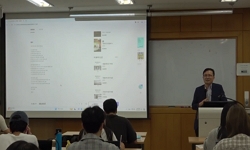1 이석규, "현대국어 정도 어찌씨의 의미 연구" 건국대학교 1987
2 박동근, "현대국어 강조부사 범주의 설정과 기능적 분석" 한글학회 (275) : 129-163, 2007
3 강범모, "한국어의 텍스트 장르와 언어 특성" 고려대학교 출판부 1999
4 진제희, "한국어 학습자들의 발화 속에 나타난 대화 전략으로서의 입말의 특성" 국제한국어교육학회 2 (2): 275-293, 2001
5 강범모, "한국어 텍스트의 장르, 문체, 유형: 컴퓨터와 통계적 기법의 이용" 태학사 2000
6 박선자, "한국어 어찌말의 통어의미론" 세종출판사 1996
7 강범모, "한국어 사용 빈도" 한국문화사 2009
8 안주호, "한국어 구어에서 정도부사 ‘되게’에 대하여" 언어과학회 24 : 149-166, 2003
9 국어연구원, "표준국어대사전" 두산동아 1999
10 박미선, "중국인 학습자의 정도부사 ‘너무’의 사용 경향 연구-중국 요녕대학교 한국학과 학습자를 대상으로-" 이중언어학회 (37) : 85-112, 2008
1 이석규, "현대국어 정도 어찌씨의 의미 연구" 건국대학교 1987
2 박동근, "현대국어 강조부사 범주의 설정과 기능적 분석" 한글학회 (275) : 129-163, 2007
3 강범모, "한국어의 텍스트 장르와 언어 특성" 고려대학교 출판부 1999
4 진제희, "한국어 학습자들의 발화 속에 나타난 대화 전략으로서의 입말의 특성" 국제한국어교육학회 2 (2): 275-293, 2001
5 강범모, "한국어 텍스트의 장르, 문체, 유형: 컴퓨터와 통계적 기법의 이용" 태학사 2000
6 박선자, "한국어 어찌말의 통어의미론" 세종출판사 1996
7 강범모, "한국어 사용 빈도" 한국문화사 2009
8 안주호, "한국어 구어에서 정도부사 ‘되게’에 대하여" 언어과학회 24 : 149-166, 2003
9 국어연구원, "표준국어대사전" 두산동아 1999
10 박미선, "중국인 학습자의 정도부사 ‘너무’의 사용 경향 연구-중국 요녕대학교 한국학과 학습자를 대상으로-" 이중언어학회 (37) : 85-112, 2008
11 손춘섭, "정도부사의 의미와 기능에 대한 고찰" 한국어의미학회 9 : 97-130, 2001
12 신지연, "정도부사의 범주화 기준에 대하여" 한국어문학회 78 : 71-87, 2002
13 박소영, "정도부사 ‘아주’, ‘거의’, ‘매우’의 의미와 분포" 담화와인지언어학회 8 (8): 85-108, 2001
14 임규홍, "정도부사 '너무'의 어형성과 공기 특성" 우리말글학회 (32) : 77-100, 2004
15 강범모, "언어, 컴퓨터, 코퍼스 언어학" 고려대학교 출판부 2003
16 한나래, "세종 구어 코퍼스를 이용한 성별, 사용역별 언어 사용 차이의 연구" 2009
17 임규홍, "부사 ‘정말’류의 담화적 의미" 한국어의미학회 2 : 237-254, 1998
18 구현정, "대화의 기법" 경진 2009
19 임규홍, "국어 정도 부사 '너무'의 화용론적 의미" 배달말학회 (30) : 1-22, 2002
20 손남익, "국어 부사 연구 : 정도부사의 통사․의미론적 연구를 중심으로" 고려대학교 1990
21 손남익, "국어 부사 연구" 박이정 1995
22 Tannen, D, "You Just Don't Understand: Women and Men in Conversation" Ballantine 1991
23 Sinclair, J, "Words and phrases. Corpus, Concordance, Collocation" OUP 70-75, 1991
24 Partington, A, "Utterly content in each other's company: Semantic prosody and semantic preference" 9 (9): 131-156, 2004
25 McCarthy, M, "Spoken Language and Applied Linguistics" Cambridge University Press 1998
26 Nevalainen, T, "Social variation in intensifier use: constraint on -ly adverbialization in the past?" 12 : 289-315, 2007
27 Tagliamonte, S, "So weird; So cool; So innovative: The use of intensifiers in the television series FRIENDS" 80 (80): 280-300, 2005
28 Bednarek, M, "Semantic preference and semantic prosody re-examined" 4 (4): 119-139, 2008
29 Bradac, J. J, "Men’s and Women’s Use of Intensifiers and Hedges in Problem-Solving Interaction: Molar and Molecular Analyses" 28 (28): 93-116, 1995
30 Mulac, A, "Male/female language differences and attributional consequences in a public speaking situation: Toward an explanation of the gender-linked language effect" 53 : 115-128, 1986
31 Lakoff, R, "Language and Women's Place" Harper and Row 1975
32 Louw,B, "Irony in the text or insincerity in the writer?"
33 Vasilieva, I, "Gender-specific use of boosting and hedging adverbs in English computer-related texts - a corpus based study"
34 Graddy, D. B, "Gender salience and the use of linguistic qualifiers and intensifiers in online course discussions" 20 (20): 211-229, 2006
35 Nemati, A, "Gender differences in the use of linguistic forms: A comparative study of Persian and English" 7 (7): 2007
36 Hoey, M, "From concordance to text structure: new uses for computer corpora" Lodz University Press 2-23, 1997
37 Tognini-Bonelli, E, "Corpus Linguistics at Work" John Benjamins 2001
38 Louw, B, "Contextual prosodic theory: Bringing semantic prosodies to life in: Words in Context: A Tribute to John Sinclair on his Retirement" University of Birmingham 2000
39 Bunz, U, "Accommodating politeness indicators in personal electronic mail messages" 2003
40 장영희, "20대 남녀 사용 어휘의 대비적 고찰, 국어화법과 대화분석" 한국화법학회 2 : 93-114, 2000





 DBpia
DBpia








